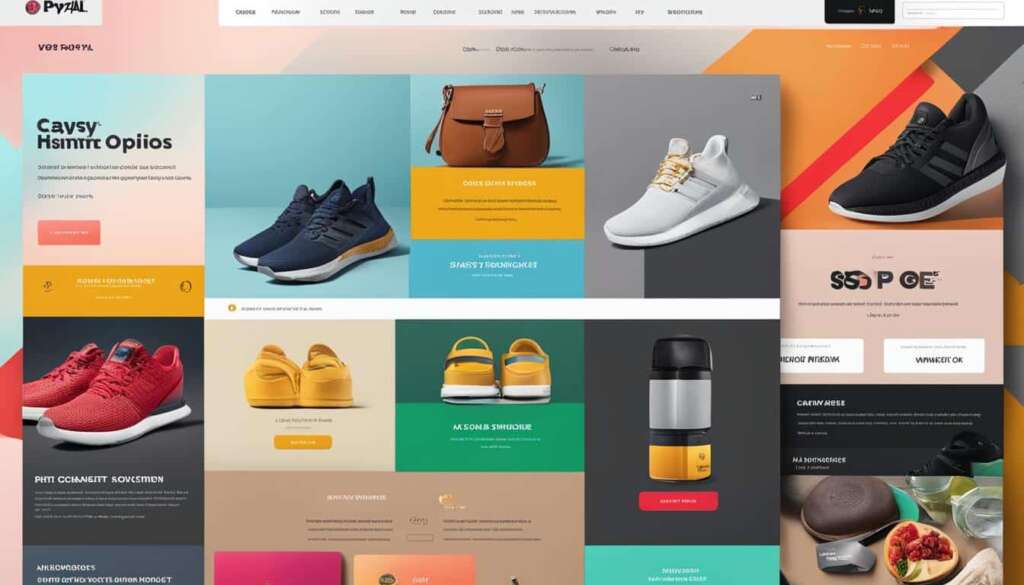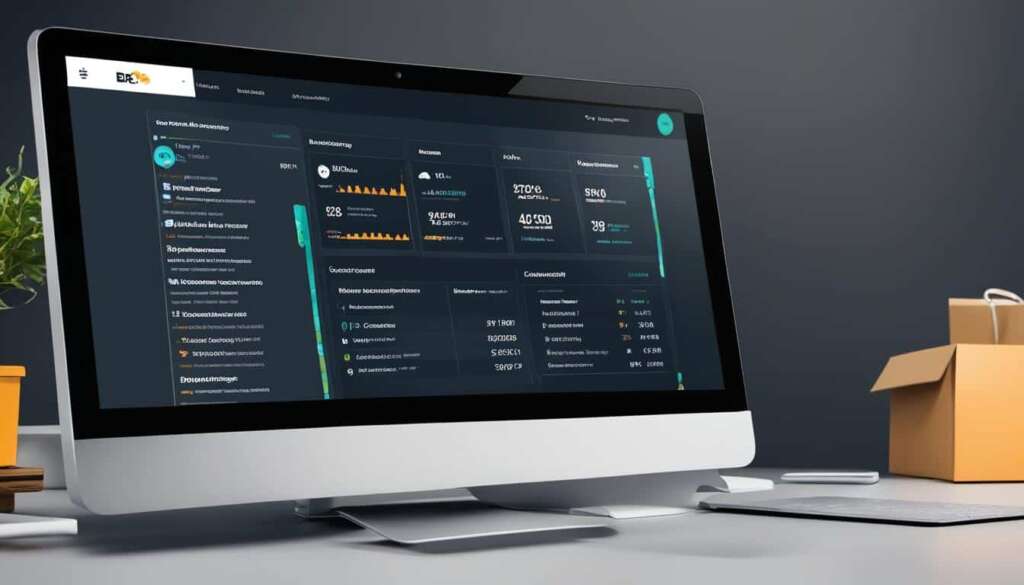Table of Contents
If you want to maximize online sales and improve user experience, it’s essential to implement e-commerce best practices. By following these strategies, you can boost conversion rates and create a successful online store.
To begin with, offering referral programs can incentivize customers to promote your store, resulting in increased sales and brand awareness. Additionally, staying in touch with prospects and customers through email marketing helps build relationships and encourages repeat purchases.
User experience is another key aspect of e-commerce success. By streamlining your website’s design and navigation, visitors can easily find the products they’re looking for, leading to higher conversion rates. Providing a seamless customer experience also includes optimizing website loading times and ensuring mobile responsiveness.
Implementing e-commerce design best practices, such as using appealing images that showcase your products, can significantly enhance customer engagement. High-quality visuals allow potential buyers to have a better understanding of your products and make informed decisions.
To gain trust from your customers, it’s important to display trust signals on your website. This can include customer reviews, testimonials, trust badges, and a secure browsing experience with a valid SSL certificate. These elements help establish credibility and reliability.
By following e-commerce best practices, you can optimize your online store and increase your chances of success in the competitive e-commerce market. In the following sections, we will delve deeper into specific strategies to enhance user experience, improve website trustworthiness, and engage customers effectively.
Get Rid of Clutter to Enhance User Experience
Getting rid of clutter on your website is an essential e-commerce homepage best practice. When visitors are greeted with too much information, they may feel overwhelmed and confused. This negatively impacts their user experience, leading to higher bounce rates and lower conversion rates. To ensure a seamless and enjoyable browsing experience, it is crucial to declutter your website and streamline the layout.
Prominently Feature Best-Selling Products
One effective way to declutter your e-commerce homepage is to showcase your best-selling products prominently. This allows visitors to quickly identify popular and desirable items, which can improve their decision-making process. Consider using a visually appealing carousel or grid layout to display your top-performing products. By doing so, you create a visually appealing experience while decluttering the homepage at the same time.
Highlight Current Promotions
Another way to enhance user experience while reducing clutter is by highlighting current promotions. Rather than bombarding visitors with multiple discounts and offers, focus on featuring a select few that are most relevant and enticing. This helps to create a sense of urgency and encourages users to explore your products and make a purchase. By keeping your promotions concise and easily visible, you can drive conversions while maintaining a clean and clutter-free homepage.
Provide a Clear Link to Your Blog
Offering additional information and resources without overcrowding your homepage is possible by providing a clear link to your blog. A well-maintained and informative blog can engage users by addressing their pain points, answering common questions, and showcasing your expertise in the industry. By directing visitors to your blog through a prominent link, you can provide them with valuable content without overwhelming the homepage with excessive text.
Remember, a clutter-free e-commerce homepage allows your visitors to focus on what matters most – your products and offers. By implementing these best practices, you can create a seamless user experience that enhances engagement and boosts conversion rates.
Make Your Website Trustworthy
Building trust with your customers is crucial for e-commerce success. When customers trust a website, they are more likely to make a purchase and engage with your brand. To establish website credibility and gain the trust of your audience, follow these e-commerce best practices:
- Implement trust signals: Incorporate trust badges such as verified payment logos or security seals on your website. These badges indicate that your site is safe and trustworthy for online transactions. Additionally, display logos of well-known partners or clients to showcase positive affiliations.
- Showcase positive press coverage: If your business has received media attention, display snippets or links to articles, reviews, or interviews on your website. This demonstrates third-party validation and builds credibility.
- Highlight customer reviews and testimonials: Feature genuine customer reviews and testimonials on your website. Authentic feedback from satisfied customers boosts confidence among potential buyers. Consider displaying ratings or star-based reviews to provide a quick overview.
- Provide contact numbers: Clearly display contact numbers on your website, allowing customers to reach out for any inquiries or support. Providing accessible customer service instills confidence and shows that you value customer satisfaction.
- Include a physical address: Add a physical address to your website, especially if you have a brick-and-mortar store. This reassures customers that your business has a legitimate presence, increasing trustworthiness.
SSL Certificate: Ensuring Secure Browsing
One essential trust signal is having a valid SSL certificate. An SSL certificate encrypts sensitive information exchanged between a website and its visitors, ensuring secure browsing. When a site has an SSL certificate, customers see a padlock icon next to the URL and the website address starts with “https://”. This enhances trust and assures users that their data is safe from potential cyber threats.
This SSL certificate also plays a role in SEO, as search engines prioritize secure websites in their rankings. This means that having an SSL certificate not only builds trust but can also improve your website’s visibility and organic search traffic.
| Benefits of implementing trust signals: |
|---|
| 1. Increases customer confidence |
| 2. Boosts credibility and reputation |
| 3. Improves conversion rates |
| 4. Reinforces brand trustworthiness |
By incorporating trust signals and implementing an SSL certificate, you can enhance website credibility and inspire trust in your customers. Building trust is an ongoing process, so regularly evaluate and improve trust-building strategies to maintain a reputable online presence.

Use Appealing Images to Grab Attention
High-quality, appealing images play a significant role in capturing customer attention and increasing engagement. Studies have shown that customers find product images more important than customer reviews or descriptions when making purchasing decisions. Visuals have the power to evoke emotions, convey information, and build brand identity, making them an indispensable part of any e-commerce design strategy.
When selecting images for your online store, it is crucial to choose attractive visuals that effectively showcase your products. Consider using a combination of high-resolution images taken from multiple angles to provide a comprehensive view of the product. This allows customers to assess its appearance and features more accurately.
Original content is key when it comes to product visuals. While third-party images may seem convenient, they lack uniqueness and fail to establish an authentic connection with your brand. By investing in professional photography or graphic design, you can create compelling visuals that resonate with your target audience and differentiate your e-commerce store from competitors.
Optimizing images for web display is another essential aspect of e-commerce design best practices. Compressing images to reduce file size without compromising quality can significantly improve website loading speed, ensuring a seamless user experience. Additionally, providing alternative text (alt tags) for each image enables search engines to understand the image content, improving your store’s SEO ranking and visibility.
Benefits of Appealing Images:
- Grab customer attention
- Enhance product visibility and understanding
- Create an emotional connection with customers
- Establish brand identity
- Improve website loading speed
- Boost SEO ranking
To illustrate the impact of appealing images, consider the following example:
A study conducted by XYZ Retail found that their conversion rates increased by 20% after replacing generic product images with professionally-shot, visually stunning visuals. The high-quality images not only attracted more customers but also conveyed the premium quality of their products, ultimately leading to higher sales and customer satisfaction.
Investing in appealing images is a worthwhile endeavor that can significantly contribute to your e-commerce success. By leveraging the power of visuals, you can engage customers, increase conversions, and convey your brand message effectively.
| Key Aspects of Appealing Images | Benefits |
|---|---|
| High-resolution visuals from multiple angles | Provide comprehensive product view |
| Original content | Establish brand authenticity |
| Image optimization | Improve website loading speed |
| Alt tags | Enhance SEO ranking |
A streamlined user interface and user experience are crucial for a seamless shopping experience on your e-commerce website. By optimizing your website’s navigation and enhancing the overall user interface, you can improve the journey of your customers and boost conversions.
Simplifying the navigation bar is the first step towards a streamlined UI/UX. Remove unnecessary clutter and focus on keeping the navigation options clear and concise. Presenting users with a clean and intuitive menu structure allows them to easily move from one product page to another without any confusion.
To further enhance user experience, consider tracking user behavior. By analyzing their browsing patterns, you can gain insights into their preferences and provide personalized recommendations. Presenting product recommendations based on their browsing and purchase history can help them discover new items and increase their time spent on your site.
Another valuable feature to consider is the “Frequently Bought Together” option. By showcasing complementary products or items commonly purchased together, you can encourage users to explore additional options and increase their overall order value.
A streamlined UI/UX not only simplifies navigation but also focuses on making the shopping process efficient and enjoyable for your customers. By implementing these e-commerce website best practices, you can optimize the user interface, improve user experience, and maximize conversions on your e-commerce site.
The Benefits of Streamlined UI/UX
- Improved Navigation: Easy-to-use menus and clear pathways ensure users find what they’re looking for quickly, reducing frustration and increasing satisfaction.
- Enhanced User Experience: By providing personalized recommendations and relevant suggestions, users feel understood and catered to, leading to higher engagement and retention rates.
- Increased Conversion Rates: A streamlined UI/UX reduces barriers to purchase, simplifies the checkout process, and ultimately boosts conversion rates.
Engage Customers with Product Demos
Product demos are a powerful tool for boosting sales in the world of e-commerce. By providing engaging videos that showcase your products, you can help customers make more informed decisions about their purchases. The visual aspect of product demos allows customers to see the product in action and get a better understanding of its features and benefits.
Creating high-quality product demos is an essential e-commerce best practice. Invest in professional video production to ensure that your demos are visually appealing and effectively convey the value of your products. Consider filming the demo in different settings to showcase the product’s versatility or demonstrate specific use cases.
Customers are more likely to make a purchase when they have a clear understanding of how a product works and how it can benefit them. Product demos provide an immersive experience that encourages customers to visualize themselves using the product, thus increasing their confidence in their purchasing decision.
When creating product demos, focus on showcasing the key features and benefits that set your product apart from competitors. Highlight any unique selling points and demonstrate how your product can solve specific pain points for your target audience. By addressing your customers’ needs and desires, you can effectively position your product as the ideal solution.
Integrate product demos into your e-commerce website to enhance the overall user experience. Feature them prominently on your product pages to capture customers’ attention and provide them with valuable information that helps them make informed buying decisions. Additionally, consider embedding product demos in related blog posts or sharing them on social media platforms to reach a wider audience.
Benefits of Product Demos:
- Engage customers and spark their interest in your products
- Demonstrate the value and benefits of your products
- Address customer pain points and highlight unique features
- Boost customer confidence in their purchase decisions
- Improve overall user experience on your e-commerce website
To maximize the impact of product demos, analyze customer feedback and engagement metrics. Use these insights to continuously improve and refine your demo content. By staying responsive to customer preferences and needs, you can ensure that your product demos effectively drive sales and increase conversion rates.
| Key Points | Product Demos |
|---|---|
| Engage Customers | Help customers make informed decisions |
| Showcase Features | Highlight unique product features and benefits |
| User Experience | Improve the overall user experience on your website |
| Boost Sales | Increase conversion rates and drive sales |

Improve Loading Times and Website Responsiveness
Slow loading times can have a negative impact on user experience and conversion rates. Studies show that even a one-second delay can lead to a 7% reduction in conversion rate. To ensure optimal performance, it is crucial to focus on improving loading times and website responsiveness.
Invest in Fast E-commerce Hosting
One of the key factors affecting loading times is the quality of your hosting service. Investing in fast e-commerce hosting can significantly improve the speed of your website. Look for hosting providers that offer reliable server infrastructure and have a strong track record of delivering swift-loading websites.
Optimize File Sizes
Minimizing the size of your website’s files, such as images, CSS, and JavaScript, can contribute to faster loading times. Compressing images without compromising their quality, minifying and combining CSS and JavaScript files, and utilizing browser caching techniques can all help reduce file sizes and enhance website performance.
Utilize Caching Plugins
Caching plugins can cache your website’s static content and serve it to users more quickly. By temporarily storing static elements like images, CSS, and JavaScript files in the user’s browser, caching plugins eliminate the need to reload the same content repeatedly, resulting in faster page load times.
Optimize Code
Clean and efficient code is essential for improving website responsiveness. Streamlining your website’s code, removing unnecessary elements, and reducing the number of HTTP requests can have a significant impact on loading times. Regularly review and optimize your codebase to ensure your website performs at its best.
Ensure Website Responsiveness
In today’s mobile-driven world, it is crucial for your website to be responsive across different devices. Responsive design allows your website to adapt to various screen sizes and provide a seamless user experience. Test your website on different devices and screen resolutions to ensure it displays properly and functions smoothly.
By prioritizing loading times and website responsiveness, you can enhance user experience, increase engagement, and improve conversion rates. Invest in fast hosting, optimize file sizes, utilize caching plugins, optimize code, and ensure website responsiveness to create a fast and user-friendly online shopping experience.
| Loading Times and Website Responsiveness Statistics | |
|---|---|
| Average Loading Time | 3 seconds |
| Conversion Rate Impact | 7% reduction for every 1-second delay |
| Optimal Loading Time Target | Less than 2 seconds |
Conclusion
Implementing e-commerce best practices is crucial for optimizing your online store and maximizing revenue. By getting rid of clutter, building trust, using appealing images, creating a streamlined UI/UX, engaging customers with product demos, and improving loading times and website responsiveness, you can enhance user experience and increase conversion rates.
When it comes to e-commerce best practices, simplicity is key. Removing unnecessary clutter from your website allows visitors to focus on your products and promotions, creating a more enjoyable browsing experience. Building trust through trust signals, such as customer reviews and testimonials, boosts credibility and encourages customers to make purchases with confidence.
Visual appeal plays a significant role in capturing customer attention. Utilize high-quality and original product images to showcase your offerings in the best light, as visuals have a greater impact than customer reviews or descriptions. A streamlined user interface and navigation make it easy for customers to find what they need, ultimately increasing their time spent on your site and likelihood of making a purchase.
Engage your customers with product demos in the form of videos, showcasing your products’ features and benefits. This valuable content helps customers make informed decisions and can significantly influence conversion rates. Lastly, improving loading times and website responsiveness is crucial, as slow-loading sites can lead to a decrease in conversions. Continuously evaluate and optimize your website to stay ahead in the competitive e-commerce market and maximize your revenue potential.
FAQ
What are some e-commerce best practices to optimize an online store?
E-commerce best practices include offering referral programs, staying in touch with prospects and customers, providing a seamless customer experience, and optimizing various aspects of the website.
How can getting rid of clutter on the website enhance user experience?
When visitors are greeted with too much information, they may feel overwhelmed and confused. By focusing on presenting best-selling products prominently, highlighting current promotions, and providing a clear link to the blog, the website becomes more user-friendly.
How can website trust be established?
Trust signals such as trust badges, positive press coverage, customer reviews and testimonials, contact numbers, and a physical address can be implemented. It is also important to have a valid SSL certificate to ensure a secure browsing experience for customers.
Why are appealing images important in e-commerce?
High-quality, appealing images play a significant role in capturing customer attention and increasing engagement. It is recommended to choose attractive images that showcase products from multiple angles and opt for original content instead of relying on third-party images.
How can a streamlined UI/UX enhance the shopping experience?
A streamlined user interface and user experience are crucial for a seamless shopping experience. Simplifying the website’s navigation bar, providing personalized recommendations based on user behavior, and implementing features like product recommendations and frequently bought together options can encourage exploration and increase time spent on the site.
How can product demos in the form of videos boost sales?
By providing videos that showcase products, customers can make informed decisions. Showing the product in action and highlighting its features and benefits can significantly influence purchase decisions and increase conversion rates.
Why is it important to improve loading times and website responsiveness?
Slow loading times can have a negative impact on user experience and conversion rates. Studies show that even a one-second delay can lead to a 7% reduction in the conversion rate. Investing in fast e-commerce hosting, optimizing website performance, and ensuring website responsiveness across different devices can help improve the overall user experience.
What is the importance of implementing e-commerce best practices?
Implementing e-commerce best practices is crucial for optimizing online stores and maximizing revenue. By getting rid of clutter, building trust, using appealing images, creating a streamlined UI/UX, engaging customers with product demos, and improving loading times and website responsiveness, user experience can be enhanced, and conversion rates can be increased. Continuous evaluation and improvement of the website are necessary to stay ahead in the competitive e-commerce market.












